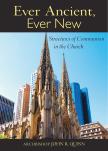Rethinking East and West
Archbishop John R. Quinn is uniquely qualified by his experience as archbishop of Oklahoma City and of San Francisco, and as president of the Unites States Conference of Catholic Bishops, to deserve a hearing when he writes about structures in the church. After an opening chapter on the nature of the church as a communion, in each of the following chapters he recalls how a particular structure has served the church’s communion in the past and suggests how it could be used more effectively as a structure of communion in the church today.
Using the term synod for regional meetings of bishops, he notes that the most common form of synods in the early church were known as provincial synods after Diocletian had organized the empire into provinces. Before that, Roman bishops were already meeting in synods at which the bishop in the principal city of the region would preside.
Archbishop Quinn cites a decree of the Council of Nicaea that shows that a bishop was accountable to the other bishops of his provincial synod. His remark that “today there are relatively few explicit requirements for bishops of the Latin Church to participate in the provincial structure of their region,” suggests his regret that there is no similar accountability among Catholic bishops today.
He begins his chapter on patriarchates by citing Canon 6 of the Council of Nicaea, which confirmed the ancient customs whereby the bishops of Alexandria, Rome and Antioch had authority beyond the limits of their own provinces. He sees in this canon an early stage of what would become the patriarchal structure of the church. During the first millennium, the patriarchal authority of the bishop of Rome came to extend over the western half of the empire, with a clear distinction between his patriarchal authority in the West and the strictly papal authority with which he judged questions about the faith of the universal church.
During the second millennium, the authority that the popes exercised continued to have the character of patriarchal administration, and through missionary expansion this kind of papal government became extended over the world-wide Catholic Church. However, as Archbishop Quinn points out, a different way of exercising papal authority was seen in the relative autonomy that the popes recognized the Eastern churches in communion with Rome to have in matters like the election of their patriarchs. The difference between the pope’s administration of the Latin Catholic Church, where he appoints all the bishops, and his exercise of papal authority over the Eastern Catholic churches is spelled out in the Code of Canons of the Eastern churches.
In his chapter on the “Modern Catholic Patriarchates,” Archbishop Quinn first describes them as they are currently realized in the Eastern Catholic churches. With the canons of those churches as his source, he explains the functions of the patriarch, the permanent and the patriarchal synods of bishops and the patriarchal assembly. He notes that the patriarchal synod makes laws for the patriarchal church, elects the patriarch and appoints all the bishops. Observing that both Ratzinger and Congar favored the creation of patriarchal structures in the Latin Church, he agrees that this could be very beneficial for the whole church.
In his chapter on deliberative synods, Archbishop Quinn recalls that at Vatican II, the Melkite Patriarch Maximos IV Saigh proposed the creation of a synod of diocesan bishops that would meet regularly with the pope to participate in the government of the universal church. Knowing that many bishops at Vatican II favored this proposal, Pope Paul VI created the Synod of Bishops at the opening of the final period of the council. He explained that while it was the task of this synod to give information and advice to the pope, it would have deliberative power when such power was given to it by the supreme pontiff. Archbishop Quinn suggests that this deliberative power would best be given to extraordinary synods, whose members are the presidents of the episcopal conferences in the Latin Church and the patriarchs and major archbishops in the Eastern Catholic churches.
In his chapter on ecumenical councils, he notes that while seven councils of the first millennium are recognized as ecumenical by both the Catholic and the Orthodox churches, the Orthodox do not recognize any councils of the second millennium as ecumenical. Since Vatican II teaches that an ecumenical council is one in which the college of bishops in communion with the pope exercises supreme authority over the whole church, Archbishop Quinn holds that according to Catholic doctrine these councils, like those of Trent, Vatican I and II are ecumenical.
The historical detail with which Archbishop Quinn has described the origin and development of five structures of the church shows that this book is the fruit not only of his many years of experience as archbishop, but also of the study of the church and its history that he has undertaken since his retirement. His knowledge of how those structures have strengthened the church’s communion in the past gives weight to his proposals as to how they could work even more effectively as structures of communion in the future. He has continued to serve the church by devoting his later years to the research that went into the writing of this book.
This article also appeared in print, under the headline “Rethinking East and West,” in the August 26-September 2, 2013, issue.








